
Why not “any” life? Allowing good interest in better news? But where do things come from? Who will have said … the relationship! The true life! Victimhood? The “true life” is thus expressed in the event of a relationship in the course of action, relationship also to things, but for the time being also to the unknown, from where the refusal … the interaction process, which informs the individual through the process of invocation [Interpellation ] allows one to identify with an imaginary representation of his/her actual social circumstances. Finding the space and the time to produce conflict, new language and expressive possibilities for one’s own desires. (…) When you make art that claims to result in confrontation with other bodies like places (and which would not), as you grow a so called oeuvre (the body of work), a strange new feeling for a body arises, it spreads at unexpected ends and corners like times, etc. (as a constantly active reconstruction activity of the past, whereby memory is expected even in the smallest parts). Which is probably not a privilege of art. In Schiller’s garden, for example. The space in which the picture especially the beloved picture is kept must be maintained. The Raeuberhauptmann’s former lover is still sitting in the garden where she was once abandoned by him. There she waits for the return of the hero undamaged.
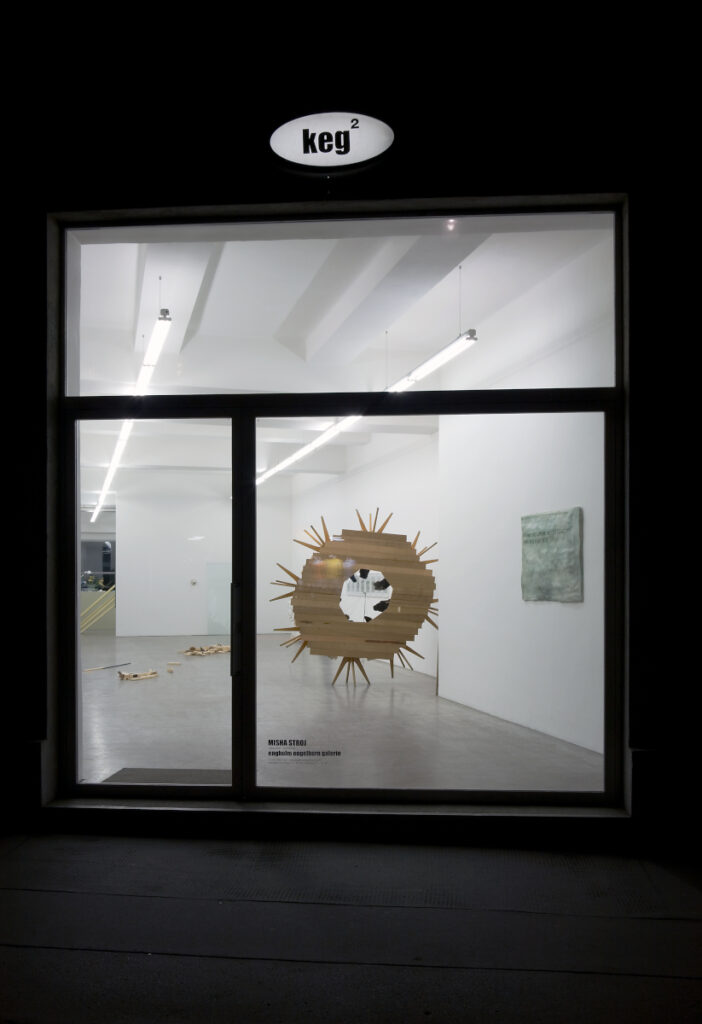

This is a shady room, and a picture that shines more from the inside than it would actually show. The room is supported by this immanent light. The cruel change of her former lover can not be accepted. The bizarre turn in Schiller: The robber can only get rid of the new image he embodies, the one who murdered, by killing the lover who kept the image of his former innocence alive …
(Schiller, The Robbers)
He sails on impetuous seas Amalia’s love sails with him he walks through unrestrained, sandy deserts Amalia’s love makes the burning sand beneath him green, and the wild shrubs bloom the midday sifts his bared head, northern snow shrinks his soles, stormy hail is raining around his temple, and Amalia’s love weighs him in storms seas and mountains and horizons between the lovers but the souls move from the dusty dungeon, and meet in the paradise of love.

entdeckung machen, entdeckung sein? (Making a discovery, Being a discovery?) (Installationsansicht) / 2006 / Show: Making a discovery, Being a discovery? / 12.05. – 25.09.2006 / Engholm Engelhorn Galerie, Vienna
The production of linguistic signs as traces of touch led to a series of reliefs. The IT is given by the text fragment above, which in turn is given by Beckett’s text “Company”. There we follow the boy at the mother’s hand. He asks the mother if in truth the distance of the sky is not greater than it appears. The repetition of the question is ambiguous, and the supposed closeness could also affect the mother’s face. The boy receives a resounding slap in response to his doubts. The openness of a linguistic sign leaves readers with an ambiguous shift: one could assume a comedy of confusions: the child does not seem to be able to distinguish the face of the mother from the sky, to identify one of the two.

if it does not appear much less distant than in reality it is / 2006 / plaster painted / 83 x 112 x 3 cm / Show: Making a discovery, Being a discovery? / 12.05. – 25.09.2006 / Engholm Engelhorn Galerie, Vienna
The recapture of this hallucinatory gaze allows the object below. The supposed face in front of the canopy can be set in motion via a hand offered to make contact, which causes it to move away and even threateningly close. The reading about the diffuse IT is readjusted. The inevitable Freud means that the ego is above all a physical one, and further that this ego is the projection of a surface. Part of an IMAGINARY MORPHOLOGY that best meets these surfaces.
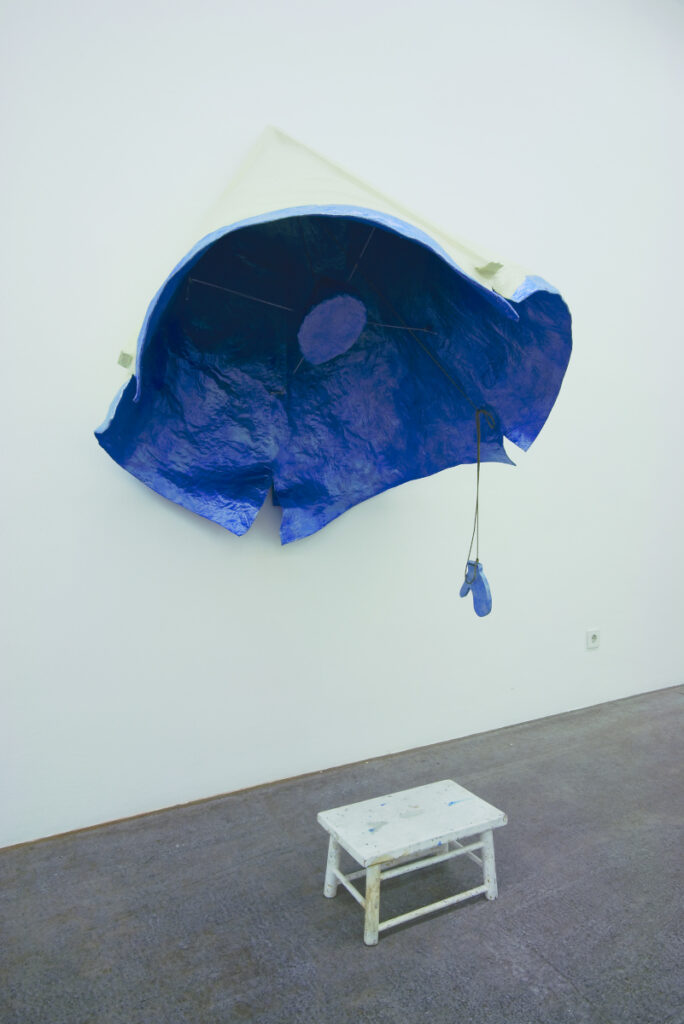
The sky that is the face that is / 2006 / papermaché, stool, cord, wood / 140 x 130 x 115 + 40 x 32 x 21 cm / Show: Making a discovery, Being a discovery? / 12.05. – 25.09.2006 / Engholm Engelhorn Galerie, Vienna
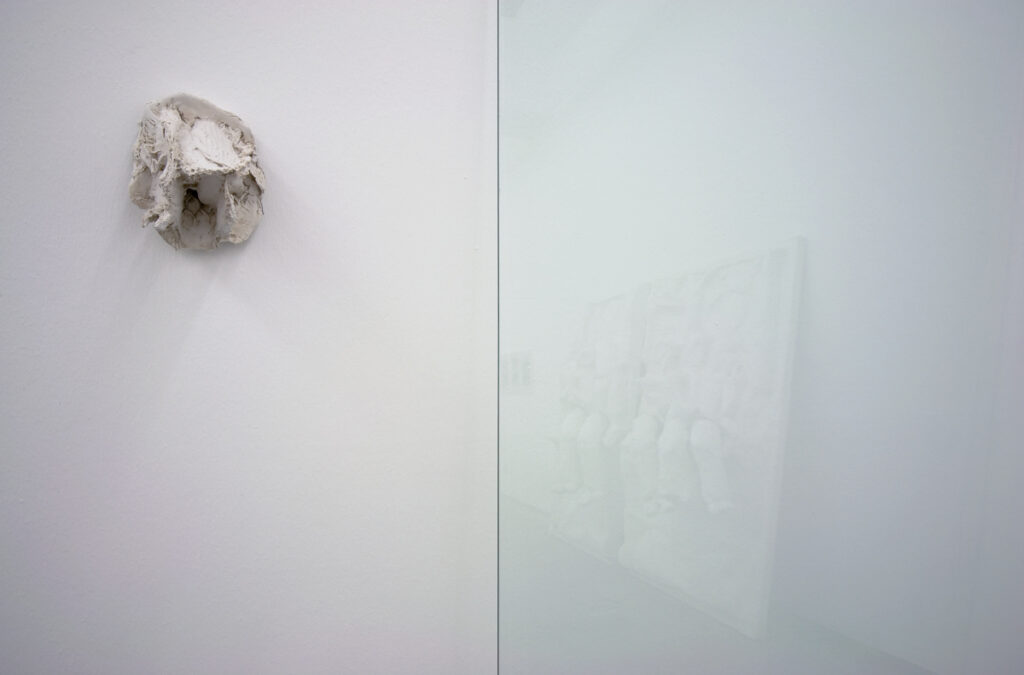
IT / 2006 / plaster, glass / 12 x 15 x 11 + 90 x 184 x 5 cm
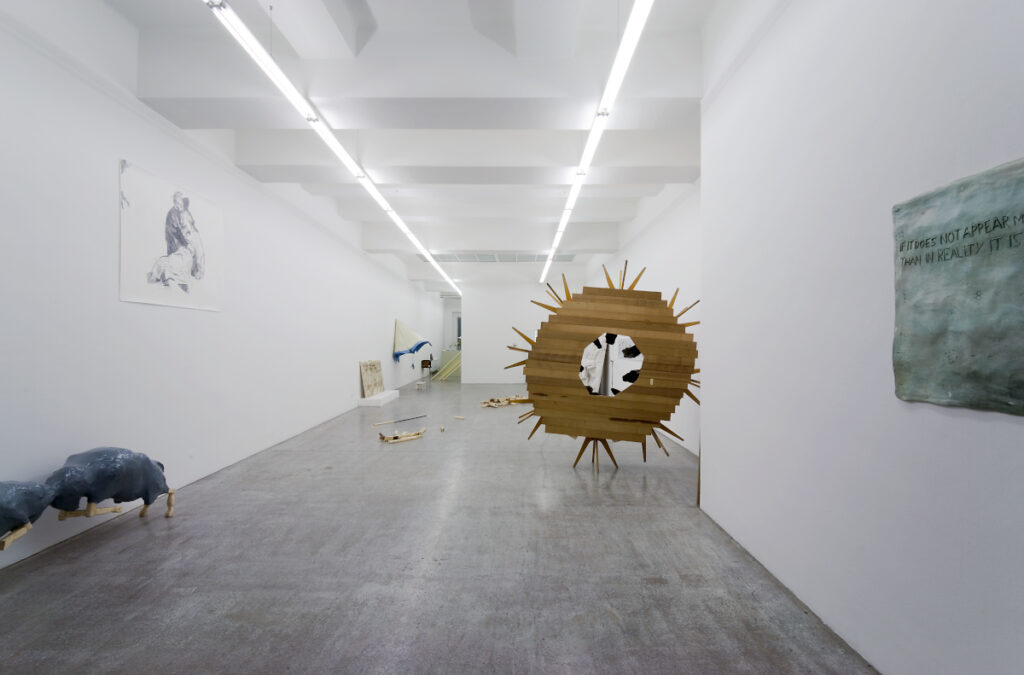
Receiving no answer you mentally reframe your question and a few hundred more. For some reason you could never have asked this question. For she shook off her little hand and made her a retort you’ve never forgotten. (Beckett, Company)
The index comes from direct contact with what IT names? Making bastards would be to mutilate symbols by touch. Just like here: The mold for the IT shown was fragile. With both hands, a necessary dry season, the artist struggled to maintain the shape. The Gestalt. The result expresses a unique event that still means that IT can become anything.
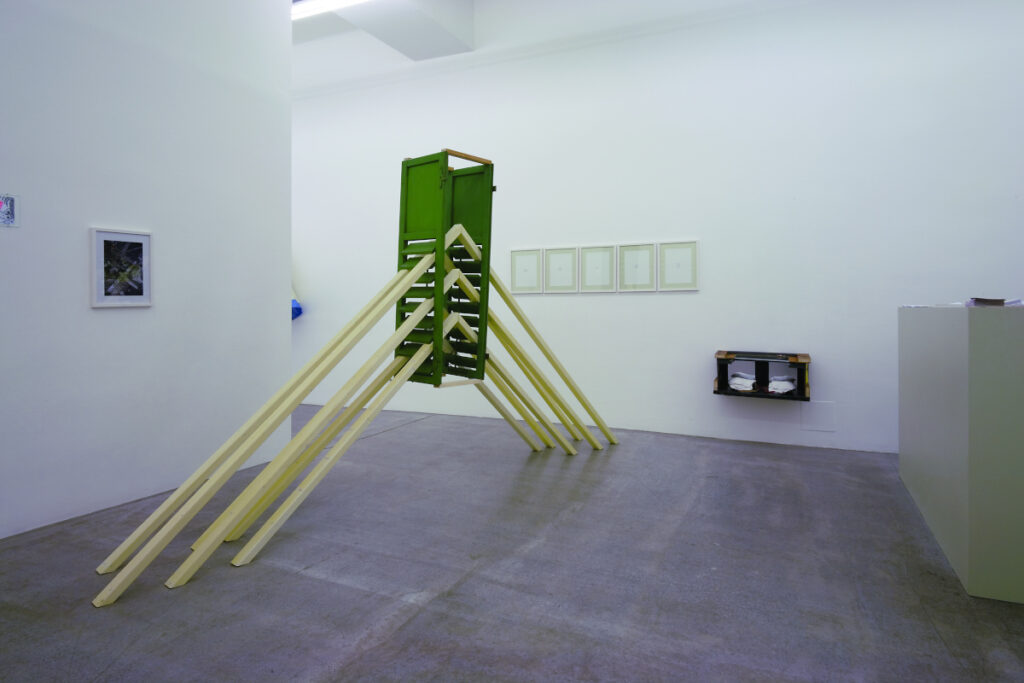
Im Garten (In the Garden) / 2006 / wood, window shades, varnish / 340 x 198 x 40 cm / Show: eine staubige landstrasse, dann saftiges grün (a dusty country road, then some juicy green) / 14.08. 16.10.2005 / Villa Merkel, Esslingen
In the forest near ‘ Helsingborg we found a gang of alert youths: it was those who, once more, had to move their tree house hiding place destroyed by the opposing gang. The urge to move, the desire for knowledge and the will to conquer, in contrast to the stiffness of the resulting trophies, are critically examined to the same extent. The engines of historiography are not so much the actual upheavals and expeditions as the production and presentation of projection screens for the image of the adventurous hero who dares to seek the other or something outside the familiar world.
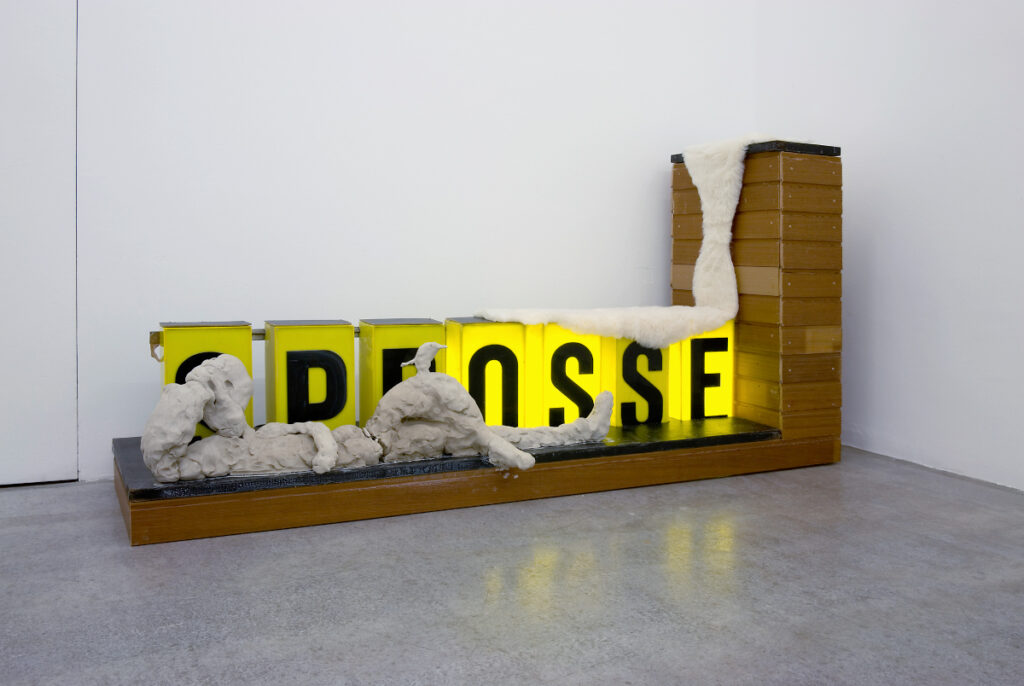
Sprosse (Sprout) / 2006 / wood, adobe, light box, flokati / 40 x 207 x 54 cm / Show: Making a discovery, Being a discovery? / 12.05. – 25.09.2006 / Engholm Engelhorn Galerie, Vienna
The artist concludes from his first experiences in the art world that this viewer’s projection surface serves to expand the possibilities of its true size, and that the production of this projection surface is currently the most value adding and promising strategy of the artist. The need for artists (still in front of the artists as he (sic!) emphasizes) seems to be greater from this somewhat paranoid view than the need for art. A discovery is always made at the expense of those who want to be undiscoverable. The quality of Stroj’s work is to make the limits of one’s own practice palpable: he shows that this experience hoped for by the beholder can not be promised through the production of solid objects (tendentially sculptures).
(Miras Ropot)
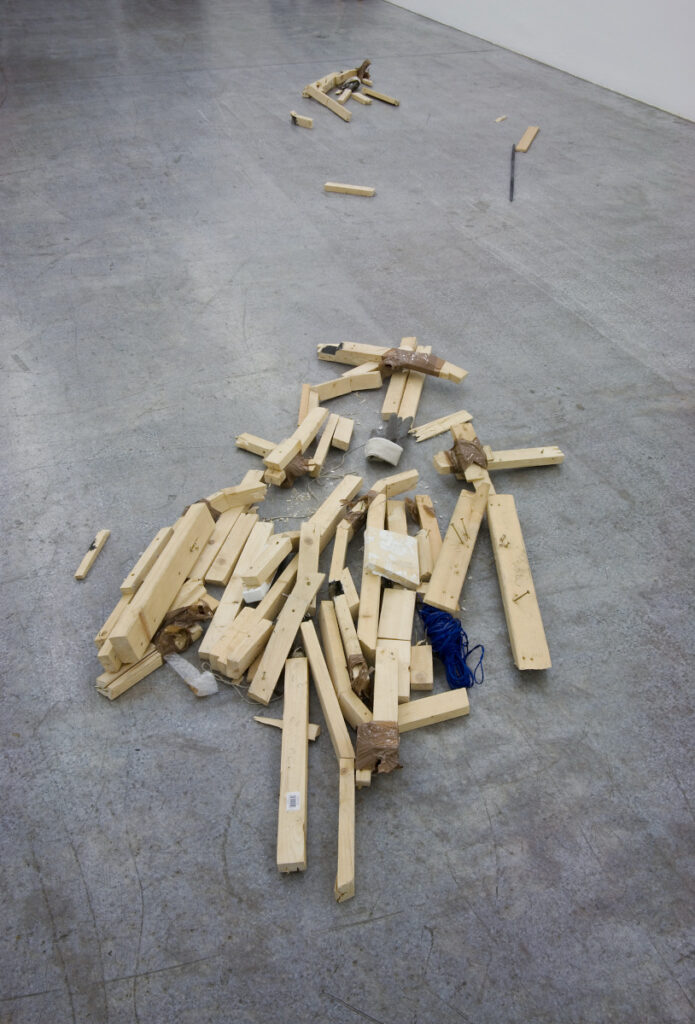
Wolke (the passenger) (Cloud (The Passenger))) / 2003 / wood, iron, gloves, string / various sizes / Show: entdeckung machen, entdeckung sein? (Making a discovery, Being a discovery?) / 12.05. – 25.09.2006 / Engholm Engelhorn Galerie, Vienna
In rundown state, the similarity of the cloud is called by name. The remnants of the returning passenger (see show at Secession) demonstrate a questionable dynamic: the material does not forget. Are the half lives of the bodies merely prolonged by the availability of souvenir stories? The denial of usefulness for the anecdote has caught up with the once pausing Passenger. I insist: identity foundation stirs in the unexpected. The rest is life.
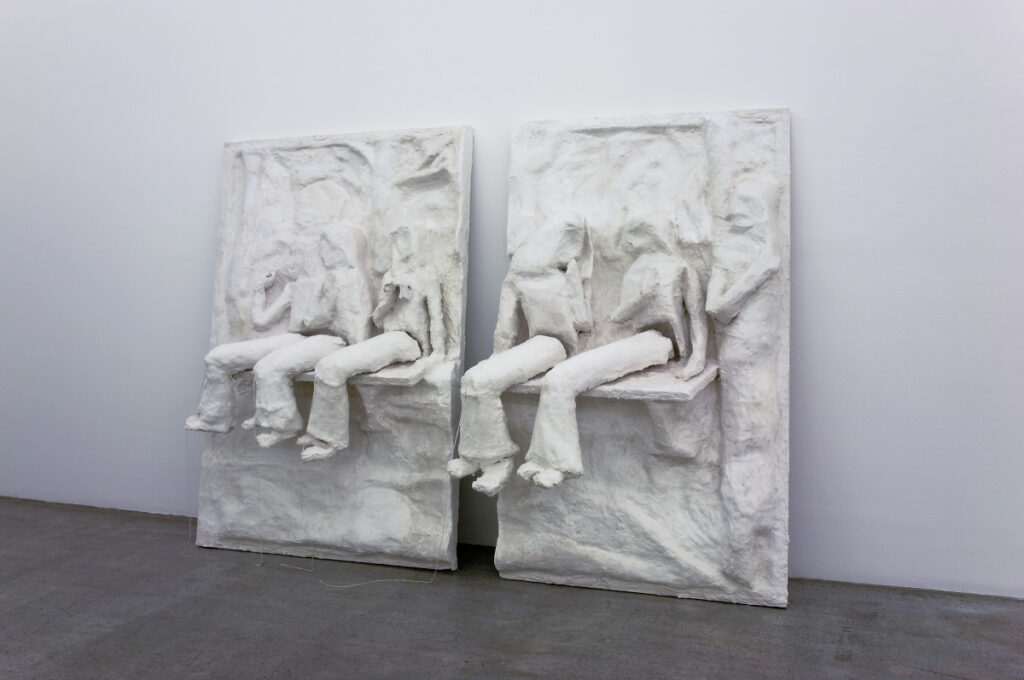
Der Markt (nach Gauguin) (The Market (after Gauguin)) / 2006 / Wood, wire, plaster / 250 x 184 x 50 cm / Show: Making a discovery, Being a discovery? / 12.05. – 25.09.2006 / Engholm Engelhorn Galerie, Vienna
A kind of (early) modern exegesis is performed on Gauguin. The translation of one of his pictures into a plaster relief is intended to examine the independence of the work’s building from what is represented, its content of invention, so to speak. Whereby the euphoria should not be too big. It is difficult to not see the fact that the paradisiacal desire to dominate is not just about color. The naivety the ignorance of the elsewhere is a facilitating rudeness in the freed dealing with the conventions of others. Gauguin’s vaunted liberation of color, the equally paradisiacal unleashing of creative power, reveals itself, among other things… the emptiness of the strange world of signs. The ordered bodies can be flattened ornamentally, and hold their unifying pose. The relief reveals the often unmentioned tension, suggesting the possibility of small gestures of resistance of the sitter by granting room for their legs. Space.
Zwischen lakonisch und skeptisch pendelt die Stimmung der neuesten Schlussfolgerungen in Misha Strojs Schaffen. Bewegungsdrang, Erkenntnislust und Eroberungswille im Gegensatz zur Steifheit der daraus resultierenden Trophäen werden im gleichen Maße kritisch untersucht. Als Motoren der Geschichtsschreibungen werden weniger die tatsächlichen Aufbrüche und Streifzüge angenommen als die Produktion und Darstellung von Projektionsflächen für das Bild vom abenteuerlustigen Helden, der es wagt, das Andere oder etwas außerhalb der vertrauten Welt zu suchen. Der Künstler schließt aus ersten Erfahrungen im Kunstbetrieb, dass diese Projektionsfläche dem Betrachter dazu dient, die Möglichkeiten ihrer wahren Größe zu expandieren, und dass die Herstellung dieser Projektionsfläche die derzeit am meisten wertsteigernde und erfolgversprechende Strategie des Künstlerwerdens sei. Der Bedarf an Künstlern (immer noch vor den Künstlerinnen wie er (sic!) betont) scheint aus dieser ein wenig paranoiden Sicht größer zu sein als der Bedarf an Kunst.
Eine Entdeckung gemacht wird stets auf Kosten der- oder desjenigen, die unmöglich Entdeckung sein wollen können.
Die Qualität von Strojs Arbeiten ist es, die Grenzen der eigenen Praxis spürbar zu machen: er zeigt, dass diese vom Betrachter erhoffte Erfahrung durch die Herstellung solider Dinge (tendenziell Skulpturen) nicht versprochen werden kann. Daher schlägt Stroj dieses Mal einen fundamentalistischen Verzicht auf die Herstellung von Ersatzwelten und Personen vor. Dieser Verzicht fände statt, wenn es gelänge, die oft versuchte Konzeption eines Blickes, der Berührung ist, tatsächlich konstruktiv herzustellen. Stroj gibt zu, dass seine Skulpturen immer noch mehr der Rede einer solchen Berührung entsprechen als der Berührung selbst, und will dieses Versprechen auch gar nicht erfüllen. Wie „Entdeckung“ mag er auch „Berührung“ unter den Umständen einer institutionalisierten Begegnung nur als sprachliches Substantiv wahr haben.
In der Ausstellung werden die Spuren folgender Bezüge bzw. Werke zu finden sein:
Die Darstellung der Sehnsucht, der Aufbrüche und Abstände wird in diversen Reliefs variiert (z.Bsp. „Der Markt (nach Gauguin)“, 2006, Gips, 250 x 184 x 50 cm). Das Relief wird meist orts- bzw. gebäudegebunden konzipiert und drückt in Strojs Augen einen verhaltenen Expansionsdrang aus.
Eine andere Arbeit versucht sich an einer Art halluzinatorischem Blick, der nicht imstande ist genau zu unterscheiden und zu identifizieren. Samuel Becketts Company erzählt von einem Jungen, der seine Mutter mehrmals fragt, ob in Wahrheit der Abstand des Himmels nicht größer sei als er erscheint. Die Wiederholung der Frage ist zweideutig, und die vermutete Nähe des Himmels könnte auch das Gesicht der Mutter betreffen, die die Zweifel ihres Sohnes mit einer schallenden Ohrfeige beantwortet. In der Arbeit „the sky that is the face that is“, Gips, Hocker, Kordel, Holz, 140 x 130 x 115 cm, 2006 wird diese Szene in eine interaktive Skulptur übersetzt, in der die drohende auf-und abwärts Bewegung der schlagenden Hand nachgestellt ist.
Das heilsame einer jeden Kontaktaufnahme wird in Bezug zu einem Detail aus Tolstojs „Der Tod des Iwan Illjitsch“ dargestellt. Der Protagonist der Erzählung erkrankt an der Unaufrichtigkeit und Lieblosigkeit seiner entfremdeten Umgebung. Trostvolle und schmerzfreie Stunden findet er wenn er seinen Diener kommen lässt, um dann seine beiden Beine auf den Schultern des einfachen Bauern hochzulagern. Pasolini übernimmt dieses Detail in seinem Film Teorema. Dort ist es ein geheimnisvoller Gast, der die Mitglieder einer wohlhabenden Industriellenfamilie völlig aus den Bahnen wirft: nicht nur durch seine unmittelbare Natürlichkeit (wie Pasolini betont) sondern auch durch tatsächliche Berührungen. Stroj interessieren die Versprechungen der ins Haus geholten Kunstwerke, wenn nicht gar Künstler, und er überlegt diverse Anlässe, bei denen er seine Schultern zur Verfügung stellen kann (Künstlerschulter (Gerassim), Holz, Papier, Gips, 2006)








